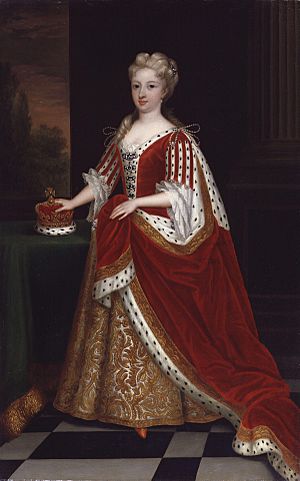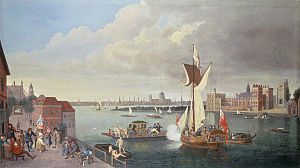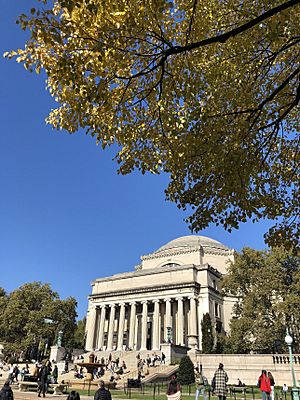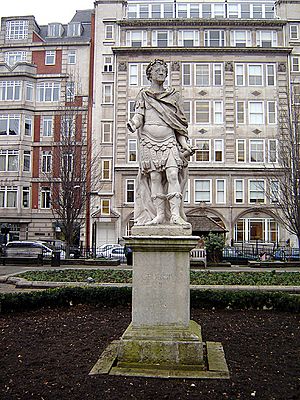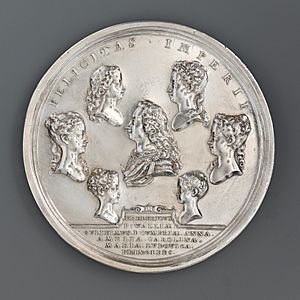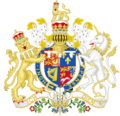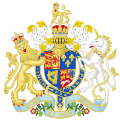George II of Great Britain facts for kids
Quick facts for kids George II |
|||||
|---|---|---|---|---|---|
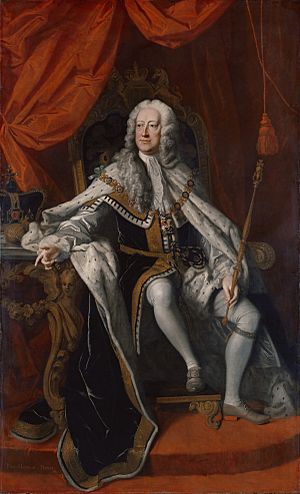
Portrait by Thomas Hudson, 1744
|
|||||
| King of Great Britain and Ireland, Elector of Hanover |
|||||
| Reign | 11/22 June 1727 – 25 October 1760 |
||||
| Coronation | 11/22 October 1727 | ||||
| Predecessor | George I | ||||
| Successor | George III | ||||
| Born | 30 October / 9 November 1683 Herrenhausen Palace, or Leine Palace, Hanover |
||||
| Died | 25 October 1760 (aged 76) Kensington Palace, London, England |
||||
| Burial | 11 November 1760 Westminster Abbey, London |
||||
| Spouse | |||||
| Issue Detail |
|||||
|
|||||
| House | Hanover | ||||
| Father | George I of Great Britain | ||||
| Mother | Sophia Dorothea of Celle | ||||
| Religion | Protestant | ||||
| Signature |  |
||||
George II (born George Augustus; 30 October / 9 November 1683 – 25 October 1760) was the King of Great Britain and Ireland. He was also the Duke of Brunswick-Lüneburg (a region in Germany, also known as Hanover). He was a prince-elector of the Holy Roman Empire from 1727 until his death in 1760.
George was born and grew up in northern Germany. He is the last British king to have been born outside Great Britain. Rules like the Act of Settlement 1701 and the Acts of Union 1707 made sure that his grandmother, Sophia of Hanover, and her Protestant family would inherit the British throne. After Sophia and Anne, Queen of Great Britain died in 1714, George's father became King George I.
As king from 1727, George didn't have much control over British politics. The Parliament of Great Britain mostly handled these matters. However, as the Elector of Hanover, he spent many summers there. He had more direct power over government decisions in Hanover. He had a difficult relationship with his oldest son, Frederick, Prince of Wales, who often sided with the political opposition.
During the War of the Austrian Succession, George led his army in the Battle of Dettingen in 1743. This made him the last British monarch to lead troops in battle. In 1745, supporters of a different claimant to the throne, known as Charles Edward Stuart or "Bonnie Prince Charlie", tried to remove George from power. This was the last of the Jacobite rebellions, but it failed. George's son Frederick died in 1751. George was then succeeded by Frederick's oldest son, George III.
For a long time after his death, people didn't think highly of George II. They focused on his short temper. But now, historians see that he had more influence on foreign policy and military choices than once thought.
Contents
Early Life and Family
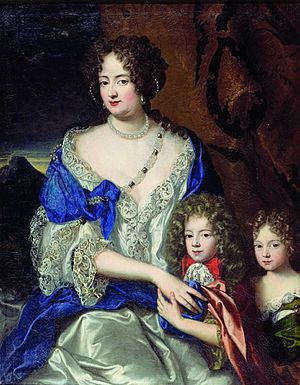
George was born in Hanover, Germany. His sister, Sophia Dorothea, was born three years later. Their parents were George Louis (who later became King George I of Great Britain) and Sophia Dorothea of Celle. In 1694, his parents' marriage ended. His mother was kept away from her children and probably never saw them again.
George spoke French until he was four years old. Then he learned German. He also learned English and Italian. He was very good at studying family history, military history, and battle plans.
In 1702, George's cousin, Anne, Queen of Great Britain, became Queen of England, Scotland, and Ireland. She had no children who lived. So, the English Parliament decided that Anne's closest Protestant relatives would inherit the throne. This meant George's grandmother, Sophia of Hanover, and her family. George was third in line to the throne after his grandmother and father.
In 1705, George became an English subject. In 1706, he was made a Knight of the Garter. He also received several titles, including Duke of Cambridge. In 1707, England and Scotland joined to form the Kingdom of Great Britain. They both agreed to the same rules for who would become king or queen.
Marriage and Children
George's father wanted his son to choose his own wife. In 1705, George secretly visited the court in Ansbach, Germany. He went to meet Caroline of Ansbach. He liked her very much and decided he didn't want to marry anyone else. They signed a marriage contract in July. On 22 August 1705, Caroline arrived in Hanover for their wedding. It was held that same evening.
George wanted to fight in the War of the Spanish Succession against France. But his father wouldn't let him until he had a son. In 1707, Caroline gave birth to their son, Frederick, Prince of Wales. Soon after, Caroline became very sick with smallpox. George stayed by her side, and he also caught the illness. They both got better.
In 1708, George fought in the Battle of Oudenarde. His horse was killed, but he was not hurt. The British commander, Marlborough, said George was very brave. Between 1709 and 1713, George and Caroline had three more children: Anne, Amelia, and Caroline.
By 1714, Queen Anne was not well. British politicians who supported the Hanoverian family wanted one of them to live in England. This was to make sure the Protestant succession was safe. George was a duke, so it was suggested he join Parliament. But both Anne and George's father said no. George didn't go. Later that year, both Sophia and Anne died. George's father became king.
Prince of Wales
George and his father sailed to England in September 1714. They arrived in London a few days later with a big parade. George was given the title of Prince of Wales. Caroline and their daughters came to Britain in October. Their son Frederick stayed in Hanover for his education. London was much bigger than anything George had seen. He tried to be popular with the English people.
In 1716, the King went back to Hanover for six months. George was given limited power to rule in his father's place. He traveled around southern England. People were allowed to watch him eat in public. Someone tried to attack him at a theater, which made him even more famous.
His father was jealous of George's popularity. This made their relationship difficult. In 1717, George's second son, Prince George William, was born. The King chose a sponsor for the baby's baptism. George didn't like this person and insulted him. The King was very angry. George and Caroline were kept in their rooms and then sent away from the King's palace. Their children stayed with the King.
George and Caroline missed their children very much. They even secretly visited the palace once. Caroline fainted, and George cried. The King later allowed them to visit once a week. In 1718, Prince George William died when he was only three months old. His father was with him.
Political Challenges
Because he was banned from the palace, George became a symbol for those who opposed his father's policies. His home became a meeting place for politicians who were against the King. These included Sir Robert Walpole.
The King visited Hanover again in 1719. Instead of letting George rule, he set up a council. In 1720, Walpole helped the King and George make up. Walpole returned to the government. But George was not happy with the agreement. His daughters were not returned to him, and he still couldn't be regent when the King was away. He thought Walpole had tricked him. For the next few years, George and Caroline lived quietly. They had three more children: William, Mary, and Louisa.
In 1721, a financial crisis called the South Sea Bubble helped Walpole become very powerful. Walpole and his political party, the Whigs, controlled politics. The King was afraid that the Tories (another political party) would not support the rules for who would become king. The Whigs were so strong that the Tories didn't hold power for another 50 years.
Becoming King
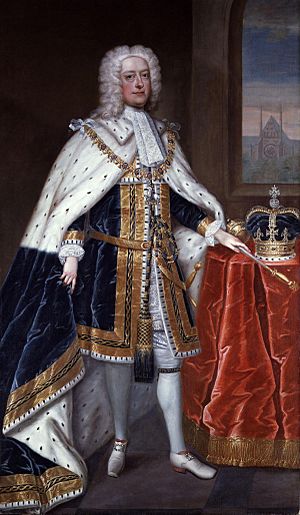
King George I died in June 1727 while visiting Hanover. George II became king and elector at 43 years old. The new king decided not to go to his father's funeral. The English people praised him for this, seeing it as a sign of his love for England. He also hid his father's will. The will tried to divide the Hanoverian lands between his future grandsons, but George II believed it was against the law.
George II was crowned at Westminster Abbey in October 1727. George Frideric Handel wrote four new songs for the coronation, including Zadok the Priest.
Many people thought George would fire Walpole. But Caroline advised George to keep Walpole. Walpole also helped George get a large amount of money from Parliament for his official expenses. Walpole had a lot of support in Parliament, so George had to keep him.
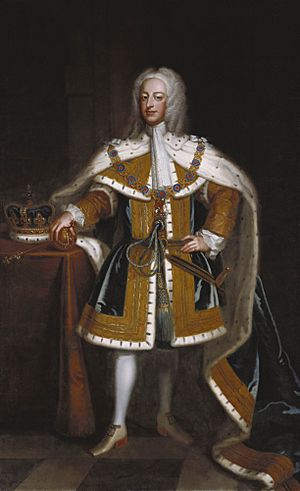
Walpole managed British politics and foreign policy. Historians generally think George mostly followed Walpole's advice. The King wanted to go to war in Europe, but his ministers were more careful. A peace deal was made in a war with Spain. George wanted Walpole to join a war in Poland, but he didn't. In 1733, Walpole removed an unpopular tax bill. George supported Walpole by firing people who opposed the bill from their jobs at court.
Family Disagreements
George II's relationship with his son Frederick, Prince of Wales, got worse in the 1730s. Frederick had stayed in Germany when his parents moved to England. They hadn't seen each other for 14 years. When Frederick came to England in 1728, he quickly became a leader for the political opposition. When George visited Hanover, he left his wife in charge of Britain, not his son.
George II also had tension with his cousin, Frederick William I of Prussia. They even thought about fighting a duel. Plans for Frederick, Prince of Wales, to marry Frederick William's daughter didn't work out. Instead, Frederick married Princess Augusta of Saxe-Gotha in 1736.
In 1736, George went back to Hanover, which made him unpopular in England. People even put up a sarcastic sign at the palace. It said a man had "lost or strayed" who left his wife and children. George returned to England in January 1737. He got sick, and his son Frederick spread rumors that the King was dying. George had to get up and attend an event to show he was fine.
An open argument happened when Frederick asked Parliament for more money. The King offered a private deal, but Frederick said no. Parliament voted against Frederick, but George reluctantly gave him more money. More problems came when Frederick took his wife, who was in labor, away in a coach at night. He didn't want the King and Queen at the birth of his daughter. George then banished Frederick and his family from the royal court.
Soon after, George's wife Caroline died in November 1737. He was very sad about her death.
Wars and Rebellions
Against Walpole's wishes, Britain started fighting Spain again in 1739. This conflict, called the War of Jenkins' Ear, became part of the larger War of the Austrian Succession in Europe. This war started when Emperor Charles VI died in 1740. The main issue was whether his daughter, Maria Theresa, could inherit his lands in Austria. George spent summers in Hanover, where he could get more involved in European politics.
Prince Frederick actively supported the opposition in the 1741 election. Walpole lost his majority and retired in 1742 after more than 20 years in power. Lord Wilmington replaced him, but the real power was held by others, like Lord Carteret, who was George's favorite minister. When Wilmington died in 1743, Henry Pelham became the head of the government.

Carteret led the group that wanted war. He said French power would grow if Maria Theresa didn't become Archduchess of Austria. George agreed to send 12,000 hired soldiers to Europe to support Maria Theresa. He placed them in Hanover to protect his German lands. The British army hadn't fought a big European war in over 20 years. George wanted the army to be more professional.
An allied army fought the French at the Battle of Dettingen in June 1743. George led them to victory, becoming the last British king to lead troops in battle. However, the war became unpopular in Britain. People felt the King was putting Hanover's interests before Britain's. Carteret lost support and resigned in 1744.
There was tension between the government and George. He kept taking advice from Carteret. He also refused to include William Pitt the Elder in the government. George disliked Pitt because he had opposed policies that seemed to favor Hanover. In 1746, the government ministers resigned. George tried to form a new government, but it failed. Pelham and his group returned to power, and George had to appoint Pitt.
George's French enemies encouraged the Jacobites to rebel. The Jacobites supported James Francis Edward Stuart, who was a Catholic claimant to the British throne. His father, James II, had been removed from power in 1688. Two earlier rebellions had failed. In July 1745, James's son, Charles Edward Stuart (Bonnie Prince Charlie), landed in Scotland. George, who was in Hanover, returned to London.
The Jacobites defeated British forces in September. They then moved south into England. But they didn't get more support, and France didn't send the promised help. The Jacobites retreated back to Scotland. In April 1746, Charles faced George's son, Prince William, Duke of Cumberland, at the Battle of Culloden. This was the last major battle fought on British soil. The government army crushed the Jacobites. Charles escaped to France, but many of his supporters were caught and executed. The Jacobite threat was almost gone. The War of the Austrian Succession ended in 1748.
Planning for the Future
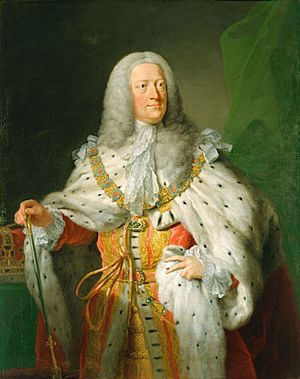
In the 1747 election, Frederick, Prince of Wales, again supported the opposition. But Pelham's party won easily. Frederick continued to host opposition leaders at his home. When Frederick died unexpectedly in 1751, his oldest son, Prince George, became the next in line to the throne. The King was very sad and cried with Frederick's wife, Princess Augusta of Saxe-Gotha.
Since Prince George would not be an adult until 1756, a new law was passed. It said that if George II died, Augusta would be regent (ruler until the new king was old enough). She would be helped by a council led by Frederick's brother, Prince William, Duke of Cumberland. The King also made a new will. It said Cumberland would be the only regent in Hanover. After his daughter Louisa died, George said, "This has been a terrible year for my family." He also said, "I know I didn't love my children when they were young... but now I love them as well as most fathers."
The Seven Years' War
In 1754, Pelham died. His older brother, Thomas Pelham-Holles, 1st Duke of Newcastle, took his place.
France and Britain continued to fight, especially over land in North America. George feared a French invasion of Hanover. So, he allied with Prussia, which was ruled by his nephew, Frederick the Great. Russia and France then allied with Austria. A French attack on the British island of Minorca started the Seven Years' War in 1756.
People were unhappy with Britain's early failures in the war. Newcastle resigned, and William Cavendish, 4th Duke of Devonshire, became prime minister. William Pitt the Elder became Secretary of State. In 1757, George fired Pitt, trying to get a government he liked more. But he couldn't form a stable government. Pitt was called back, and Newcastle returned as prime minister. Pitt then guided the war effort.
Great Britain, Hanover, Prussia, and their allies fought against France, Austria, Russia, Sweden, and Saxony. The war was fought in many places, from Europe to North America and India. British power grew with victories in India.
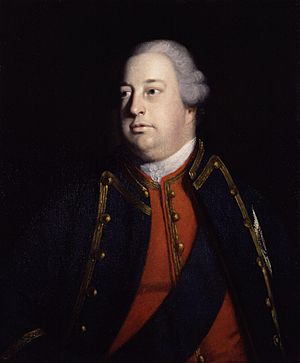
George's son, the Duke of Cumberland, led the King's troops in northern Germany. In 1757, Hanover was invaded. George gave Cumberland power to make a separate peace deal. But by September, George was furious with the deal Cumberland made. He felt it favored the French too much. George said his son had "ruined me and disgraced himself." Cumberland resigned from his military jobs. George then canceled the peace deal, saying the French had broken it.
In 1759, a great year for Britain, British forces captured Quebec and Guadeloupe. They stopped a French plan to invade Britain after naval battles. They also stopped a French advance on Hanover.
Death of the King
By October 1760, George II was blind in one eye and had trouble hearing. On the morning of 25 October, he woke up as usual. He drank hot chocolate. A few minutes later, his servant heard a loud crash. He found the king on the floor.
The King was put into his bed. Princess Amelia was called, but before she reached him, he was dead. He was almost 77 years old, living longer than any British king before him. Doctors found that he died because of a tear in a major blood vessel near his heart. His grandson, George III, became king. George II was buried on 11 November in Westminster Abbey. He had asked for the sides of his and his wife's coffins to be removed so their remains could mix.
Legacy and Impact
George gave the royal library to the British Museum in 1757. He wasn't very interested in reading or the arts. He preferred hunting or playing cards. In 1737, he founded the Georg August University of Göttingen in Hanover. He visited it in 1748. An asteroid was named after him in 1902. He also helped start King's College in New York City in 1754, which later became Columbia University. The province of Georgia in America, founded in 1732, was named after him.
During George II's reign, Britain's influence grew around the world. The threat from the Jacobites to the Hanoverian family ended. The power of ministers and Parliament in Britain became very strong.
Some people at the time described George as a weak king who was controlled by his wife and ministers. But more recent studies of his letters show that he was more involved than thought. He was especially interested in foreign policy. He could often stop ministers or commanders he disliked from getting important jobs. While he might have been seen as a bit strange by some, his biographers say he was careful with money, which is better than wasting it.
One person said his temper was quick, but he was kind and honest. He didn't pretend to be someone he wasn't. Another said that in the future, he would be seen as one of the "patriot kings" who brought happiness to their people. George might not have played the biggest role in history, but he was important at times. He also helped keep the constitutional government strong.
Family
Children
George and Caroline had eight children who were born alive. One child died very young, and seven lived to be adults.
| Name | Birth | Death | Notes |
|---|---|---|---|
| Frederick, Prince of Wales | 31 January 1707 | 31 March 1751 | married 1736, Princess Augusta of Saxe-Gotha; had children, including the future George III |
| Anne, Princess Royal | 2 November 1709 | 12 January 1759 | married 1734, William IV, Prince of Orange; had children |
| Princess Amelia | 10 June 1711 | 31 October 1786 | never married, no children |
| Princess Caroline | 10 June 1713 | 28 December 1757 | never married, no children |
| Stillborn son | 20 November 1716 | ||
| Prince George William | 13 November 1717 | 17 February 1718 | died as a baby |
| Miscarriage | 1718 | ||
| Prince William, Duke of Cumberland | 26 April 1721 | 31 October 1765 | never married, no children |
| Princess Mary | 5 March 1723 | 14 January 1772 | married 1740, Frederick II, Landgrave of Hesse-Kassel; had children |
| Princess Louisa | 18 December 1724 | 19 December 1751 | married 1743, Frederick V, King of Denmark and Norway; had children |
| Miscarriage | July 1725 | ||
|
|
|||
Images for kids
See also
 In Spanish: Jorge II de Gran Bretaña para niños
In Spanish: Jorge II de Gran Bretaña para niños


